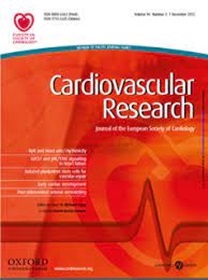Delineation of a thrombin receptor-stimulated vascular smooth muscle cell transition generating cells in the plaque-stabilising fibrous cap
IF 13.3
1区 医学
Q1 CARDIAC & CARDIOVASCULAR SYSTEMS
引用次数: 0
Abstract
Aims Vascular smooth muscle cells (VSMCs) accumulate in atherosclerotic plaques and exhibit remarkable phenotypic plasticity, contributing to both plaque growth and stability. The plaque-stabilising fibrous cap is rich in VSMC-derived cells, yet the cellular transitions and regulatory mechanisms governing fibrous cap formation remain unclear. Here, we aimed to identify the VSMC phenotypic transitions associated with this critical process. Methods and Results Mapping of lineage-traced VSMCs during plaque development revealed investment of VSMCs prior to fibrous cap formation. Using single-cell RNA-sequencing (scRNA-seq) profiles of lineage-traced VSMCs from atherosclerotic and acutely injured mouse arteries, we identified a disease-specific VSMC state co-expressing contractile genes with extracellular matrix (ECM) components (including fibrillar collagens and elastin) and NOTCH3, which are associated with fibrous cap formation. Computational trajectory analysis predicted that this proposed fibrous cap-related VSMC (fcVSMC) state arises from a previously described plastic, intermediate VSMC population expressing SCA1 and VCAM1. Clonal analysis further showed that NOTCH3+ fcVSMCs derive from intermediate VSMCs in both atherosclerosis and an acute vascular injury model, suggesting a conserved disease-relevant mechanism. The fcVSMCs were enriched in plaque fibrous caps compared to lesion cores, consistent with a role in fibrous cap formation. By combining scRNA-seq trajectory analysis and spatial transcriptomics of human atherosclerotic plaques, we identified protease-activated receptor-1 (PAR1) as a candidate regulator of fcVSMC generation. PAR1 was expressed by VSMCs in human plaque fibrous caps and PAR1 activation by thrombin induced expression of contractile genes and ECM components associated with the fcVSMC state in human VSMCs. Conclusions Our findings identify a VSMC transition linked to fibrous cap formation in atherosclerosis and show this is modelled by vascular injury. We identify VSMC-expressed PAR1 as a potential therapeutic target for promoting plaque stability by driving the transition to the matrix-producing, fibrous cap-associated VSMC state.在斑块稳定纤维帽中,凝血酶受体刺激的血管平滑肌细胞转化生成细胞的描述
目的血管平滑肌细胞(VSMCs)在动脉粥样硬化斑块中积累,并表现出显著的表型可塑性,有助于斑块的生长和稳定。斑块稳定纤维帽富含vsmc来源的细胞,但细胞转变和纤维帽形成的调节机制尚不清楚。在这里,我们的目的是确定与这一关键过程相关的VSMC表型转变。方法和结果在斑块形成过程中,对谱系追踪的VSMCs进行映射,揭示了VSMCs在纤维帽形成之前的投资。利用来自动脉粥样硬化和急性损伤小鼠动脉的单细胞rna测序(scRNA-seq)图谱,我们发现了一种疾病特异性的VSMC状态,它与细胞外基质(ECM)成分(包括纤维性胶原和弹性蛋白)和NOTCH3共同表达收缩基因,这与纤维帽的形成有关。计算轨迹分析预测,这种纤维帽相关的VSMC (fcVSMC)状态源于先前描述的表达SCA1和VCAM1的塑性中间VSMC群体。克隆分析进一步表明,NOTCH3+ fcVSMCs来源于动脉粥样硬化和急性血管损伤模型中的中间VSMCs,提示其存在保守的疾病相关机制。与病变核心相比,fcVSMCs在斑块纤维帽中富集,这与纤维帽形成的作用一致。通过结合scRNA-seq轨迹分析和人类动脉粥样硬化斑块的空间转录组学,我们发现蛋白酶激活受体1 (PAR1)是fcVSMC生成的候选调节因子。PAR1在人斑块纤维帽的VSMCs中表达,PAR1通过凝血酶激活,在人VSMCs中诱导与fcVSMC状态相关的收缩基因和ECM组分的表达。结论:我们的研究结果确定了动脉粥样硬化中与纤维帽形成相关的VSMC过渡,并表明这是由血管损伤模拟的。我们发现VSMC表达的PAR1是一个潜在的治疗靶点,通过驱动向基质生成、纤维帽相关的VSMC状态的过渡来促进斑块稳定性。
本文章由计算机程序翻译,如有差异,请以英文原文为准。
求助全文
约1分钟内获得全文
求助全文
来源期刊

Cardiovascular Research
医学-心血管系统
CiteScore
21.50
自引率
3.70%
发文量
547
审稿时长
1 months
期刊介绍:
Cardiovascular Research
Journal Overview:
International journal of the European Society of Cardiology
Focuses on basic and translational research in cardiology and cardiovascular biology
Aims to enhance insight into cardiovascular disease mechanisms and innovation prospects
Submission Criteria:
Welcomes papers covering molecular, sub-cellular, cellular, organ, and organism levels
Accepts clinical proof-of-concept and translational studies
Manuscripts expected to provide significant contribution to cardiovascular biology and diseases
 求助内容:
求助内容: 应助结果提醒方式:
应助结果提醒方式:


